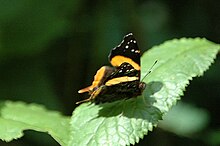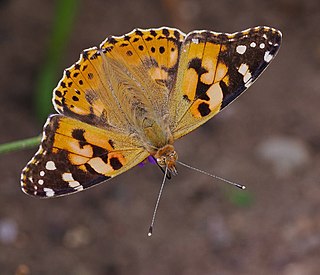
Cynthia is a group of colourful butterfly species that used to be considered a subgenus of the genus Vanessa, in the family Nymphalidae. Before that, it was first described as a genus. Nowadays, this group is not considered a valid taxon anymore, because it is paraphyletic. The name CynthiaFabricius, 1807 is now a junior subjective synonym of VanessaFabricius, 1807.

Vanessa atalanta, the red admiral or, previously, the red admirable, is a well-characterized, medium-sized butterfly with black wings, red bands, and white spots. It has a wingspan of about 2 inches (5 cm). It was first described by Carl Linnaeus in his 1758 10th edition of Systema Naturae. The red admiral is widely distributed across temperate regions of North Africa, the Americas, Europe, Asia, and the Caribbean. It resides in warmer areas, but migrates north in spring and sometimes again in autumn. Typically found in moist woodlands, the red admiral caterpillar's primary host plant is the stinging nettle ; it can also be found on the false nettle. The adult butterfly drinks from flowering plants like Buddleia and overripe fruit. Red admirals are territorial; females will only mate with males that hold territory. Males with superior flight abilities are more likely to successfully court females. It is known as an unusually calm butterfly, often allowing observation at a very close distance before flying away, also landing on and using humans as perches.

The Nymphalidae are the largest family of butterflies, with more than 6,000 species distributed throughout most of the world. Belonging to the superfamily Papilionoidea, they are usually medium-sized to large butterflies. Most species have a reduced pair of forelegs and many hold their colourful wings flat when resting. They are also called brush-footed butterflies or four-footed butterflies, because they are known to stand on only four legs while the other two are curled up; in some species, these forelegs have a brush-like set of hairs, which gives this family its other common name. Many species are brightly coloured and include popular species such as the emperors, monarch butterfly, admirals, tortoiseshells, and fritillaries. However, the under wings are, in contrast, often dull and in some species look remarkably like dead leaves, or are much paler, producing a cryptic effect that helps the butterflies blend into their surroundings.

Vanessa is a genus of brush-footed butterflies in the tribe Nymphalini. It has a near-global distribution and includes conspicuous species such as the red admirals, the Kamehameha, and the painted ladies of the Cynthia group : Painted lady, American painted lady, West Coast lady, Australian painted lady, etc. For African admirals, see genus Antanartia. Recently, several members traditionally considered to be in the genus Antanartia have been determined to belong within the genus Vanessa.

The Satyrini is one of the tribes of the subfamily Satyrinae. It includes about 2200 species and is therefore the largest tribe in the subfamily which comprises 2500 species.
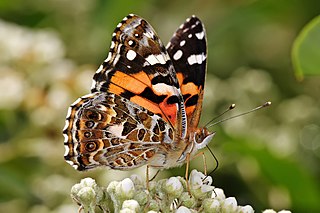
The Australian painted lady is a species of butterfly mostly confined to Australia, although westerly winds have dispersed it to islands east of Australia, including New Zealand. Debate surrounds the taxonomy of this species. Some believe that the Australian painted lady should be a subspecies of the painted lady due to the similarity in lifestyle and behaviour. Furthermore, the painted lady is found around the globe, but Australia is the only location in which it varies enough to be considered a separate species.

Brassolini is a tribe usually placed in the brush-footed butterfly subfamily Morphinae, which is often included in the Satyrinae as a tribe Morphini. If this is accepted, the Brassolini become the sister tribe of the Morphini among the Satyrinae. Formerly, they were treated as an independent family Brassolidae or subfamily Brassolinae. Many members of this tribe are called owl butterflies.
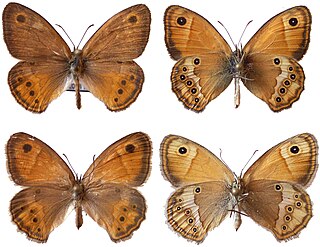
Coenonympha dorus, the dusky heath, is a butterfly of the family Nymphalidae. It is found in south-western Europe and North Africa.

Sterrhinae is a large subfamily of geometer moths with some 3,000 described species, with more than half belonging to the taxonomically difficult, very diverse genera, Idaea and Scopula. This subfamily was described by Edward Meyrick in 1892. They are the most diverse in the tropics with the number of species decreasing with increasing latitude and elevation.

Prodryas persephone is an extinct species of brush-footed butterfly, known from a single specimen from the Chadronian-aged Florissant Shale Lagerstätte of Late Eocene Colorado. P. persephone is the first fossil butterfly to be found in North America, and is exquisitely well preserved. Its closest extant relatives are the mapwings and African admirals of the genera Hypanartia and Antanartia, respectively.
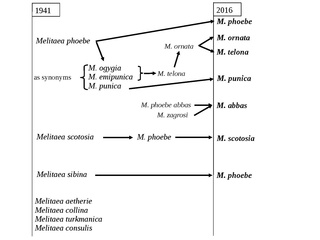
Melitaea ornata, the eastern knapweed fritillary, is a butterfly in the family Nymphalidae. The species rank of Melitaea ornata was only very recently recognised by two research groups independently. They realized that there was an unrecognised species in Europe under the name of M. phoebe. The separation of this cryptic species was based on larval morphology from the fourth instar onwards. M. phoebe larvae have a black head capsule while the larvae of this recently recognised Ponto-Mediterranean species have a brick-red head capsule. The separation of the two taxa was also supported by the results of enzyme electrophoresis study. Based on these observations, the name M. telona Fruhstorfer was taken into use for this species. In a recent molecular study, the M. phoebe group forms a monophyletic clade within the subgenus Didymaeformia. Although that study provided important results regarding the systematics of the genus, the members of the phoebe species group were poorly represented, and the need for a detailed examination of this group remained. One of the important results was the corroboration of the species rank of M. telona and the suggestion that the taxon punica may represent a separate species from both M. telona and M. phoebe. Another recent study on the morphometry of genitalia in males and females of the phoebe species group provided additional information. An analysis of a large number of specimens from the Palaearctic showed that Melitaea telona is not restricted to the Ponto-Mediterranean region since several new localities were found, including the Orenburg region (Russia), northern Iran and the easternmost border of Kazakhstan. Since the name ornata described by Hugo Theodor Christoph in 1893 is older than the name telona, the authors began to use M. ornata as the valid name for this species following the rule of priority. Recently, it has also been indicated that M. telonasensu stricto from Israel and M. ornata are different taxa. Previous morphometrical studies have already revealed small differences in the genital structures of the males but the authors interpreted the difference as a well-pronounced intra-specific difference. In contrast, molecular data clearly showed that the two taxa are genetically distinct from each other. Based on the results of the analysis of seven genes, Tóth et al. (2014) concluded that M. telona is not a subspecies of M. ornata but a species in its own right.
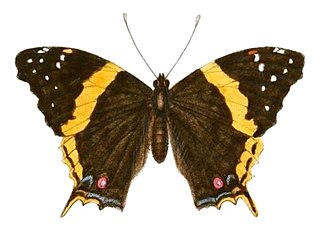
Vanessa hippomene, commonly known as the southern short-tailed admiral, is a butterfly of the family Nymphalidae which is native to South Africa and Madagascar.

Vanessa dimorphica is a butterfly of the family Nymphalidae. It is found in Africa.

Pronophilina is a Neotropical subtribe of butterflies of the subfamily Satyrinae. They are a species-rich group with highest diversity in the tropical and subtropical mountains, especially the Andes. Before 1970, they were poorly studied, but recent interest has resulted in high rates of species description from previously unexplored mountain ranges. However, there is still a lack of knowledge on their biology and ecology. Their relationship to other groups of Satyrine butterflies and their complex patterns of speciation within and among mountain ranges have led to several biogeographic discussions.

Charaxes ansorgei is a butterfly in the family Nymphalidae. It is found in Sudan, the Democratic Republic of Congo, Uganda, Rwanda, Burundi, Kenya, Tanzania, Malawi and Zambia. The habitat consists of montane forest on altitudes between 2,000 and 3,000 meters. The larvae feed on Bersama abyssinica abyssinica, Bersama abyssinica englerana and Bersama paullinoides.It was once considered to be a very rare species but it is relatively common in dense and inaccessible montane forests

Charaxes pollux, the black-bordered charaxes, is a butterfly in the family Nymphalidae.

Vanessa abyssinica, the Abyssinian admiral, is a butterfly in the family Nymphalidae. It is found in Ethiopia, Kenya, Tanzania, Uganda, Rwanda and the Democratic Republic of the Congo. The habitat consists of montane forests.

Taguaiba ypthima is a species of butterfly of the family Nymphalidae. It is found in northeastern, southeastern and southern Brazil, Paraguay and Argentina at altitudes ranging from sea level to 2,000 metres (6,600 ft).
Vanessa dilecta is a butterfly of the family Nymphalidae. The type locality is West Timor. It is sister to Vanessa buana and is sometimes lumped with that species.
Saurona is a genus of butterfly belonging to the family Nymphalidae found in the Neotropics. This genus was proposed as a new genus in 2023.
